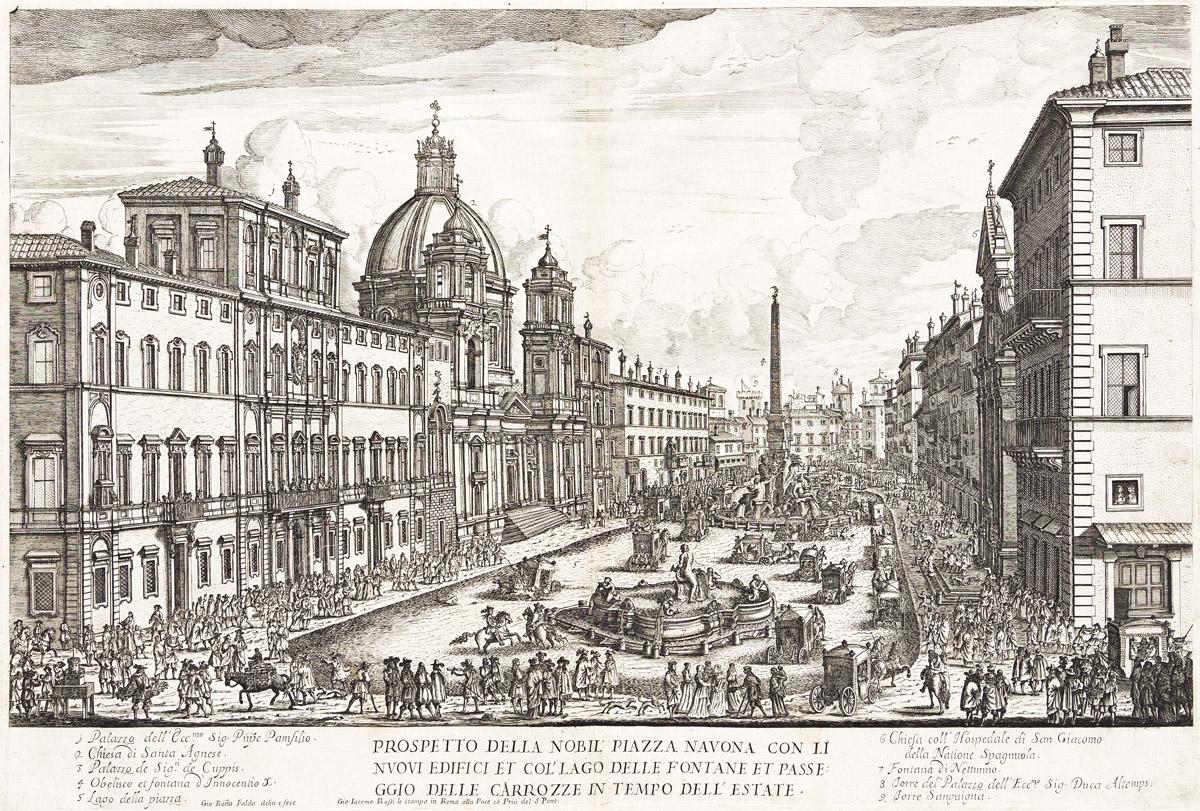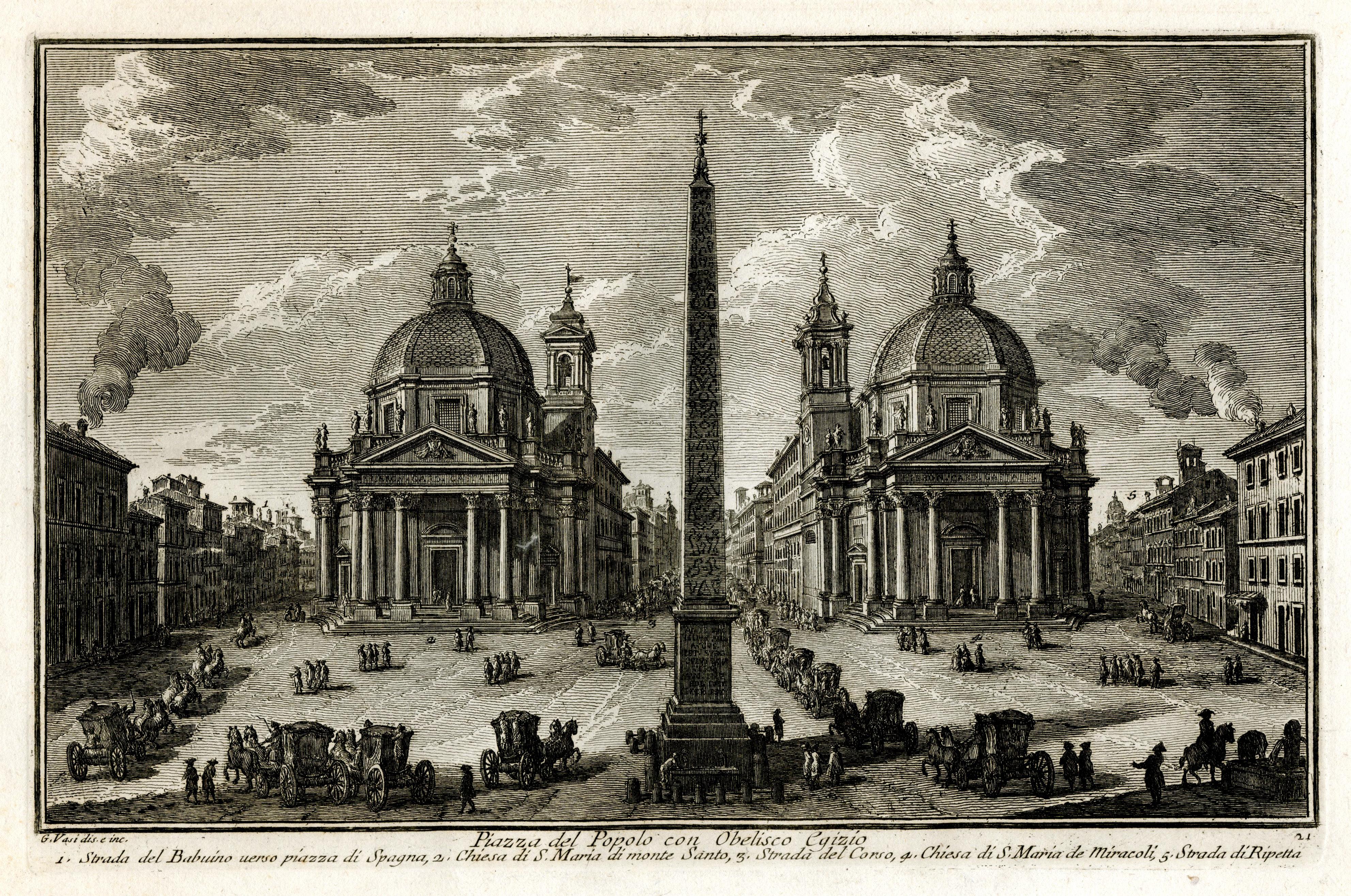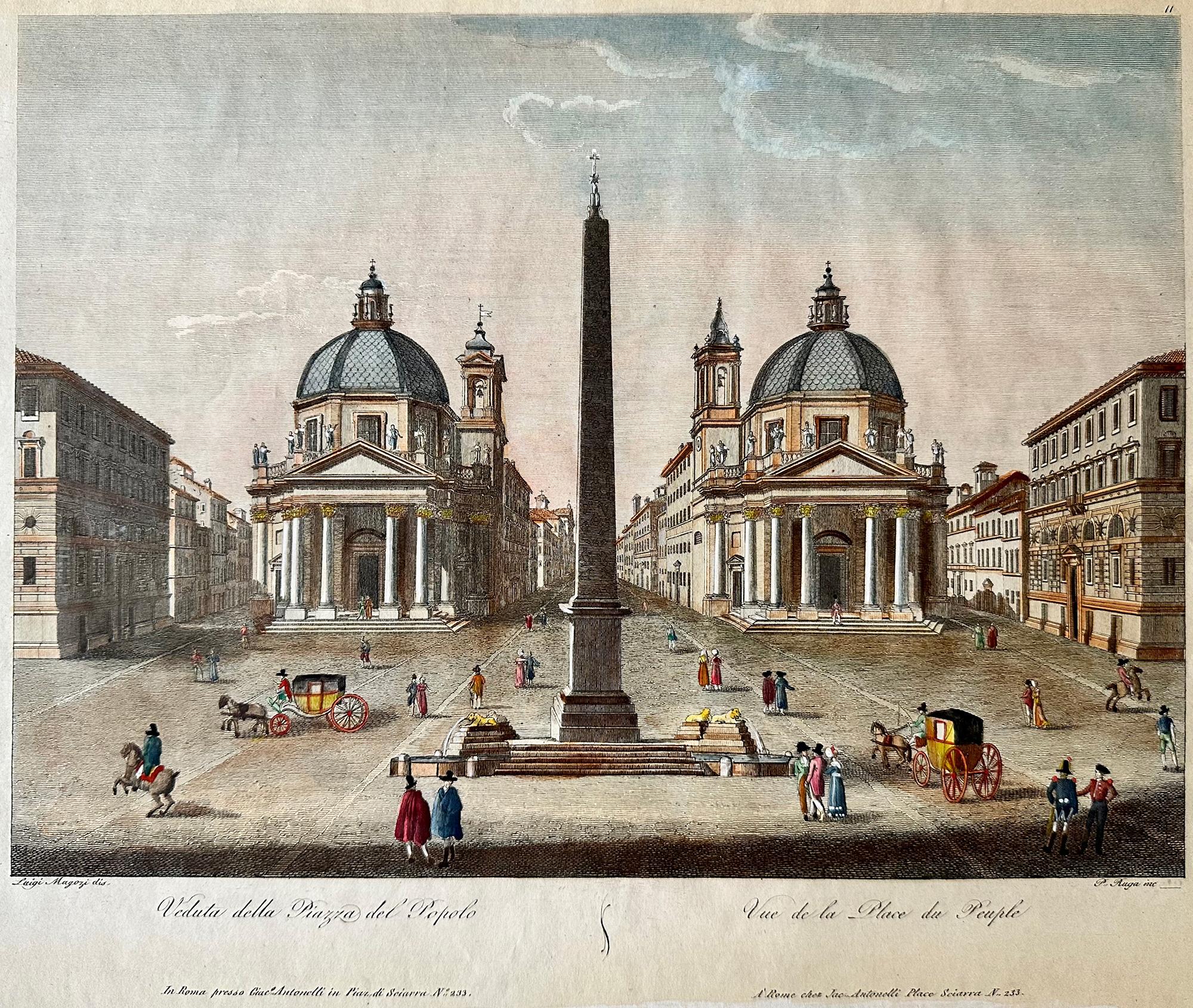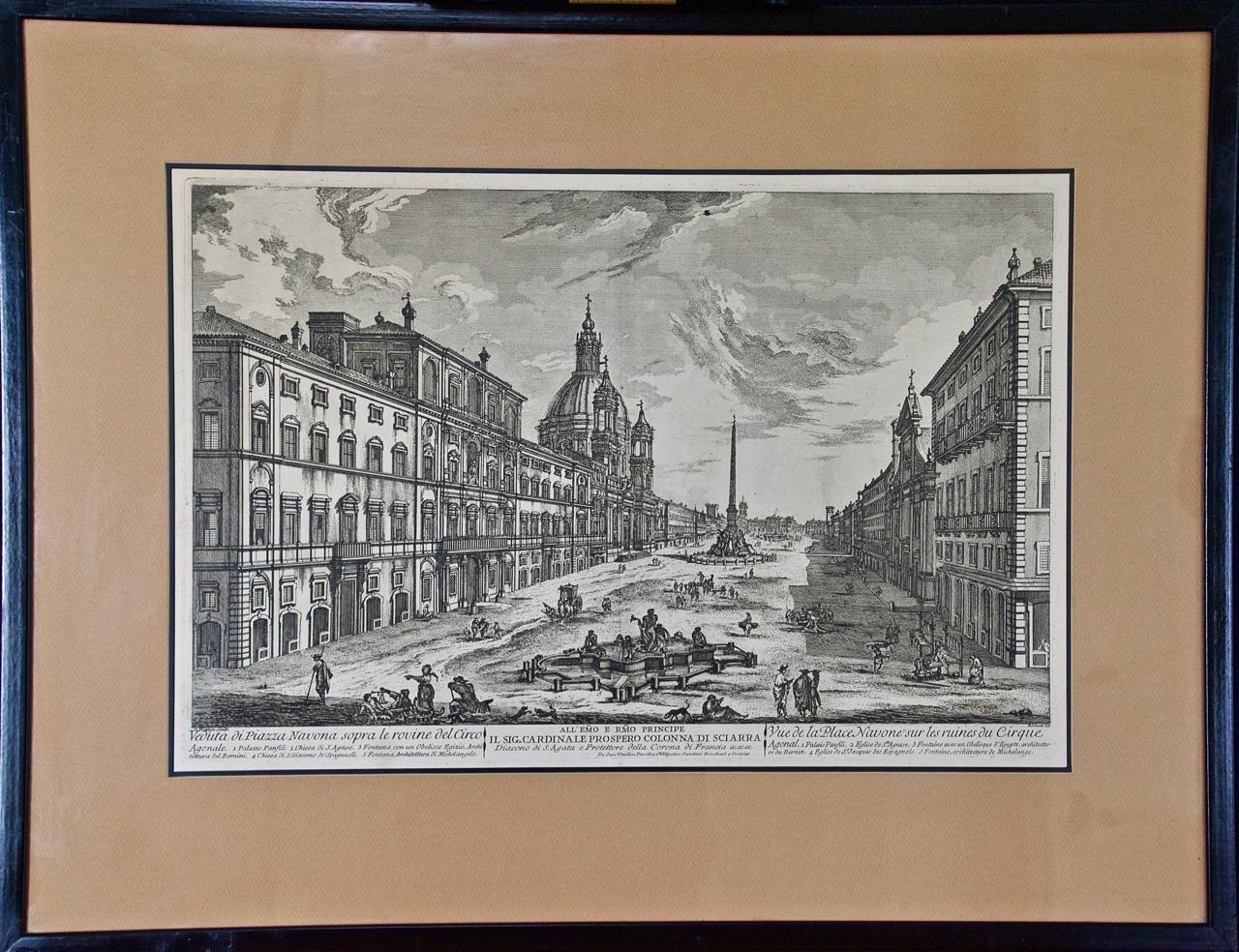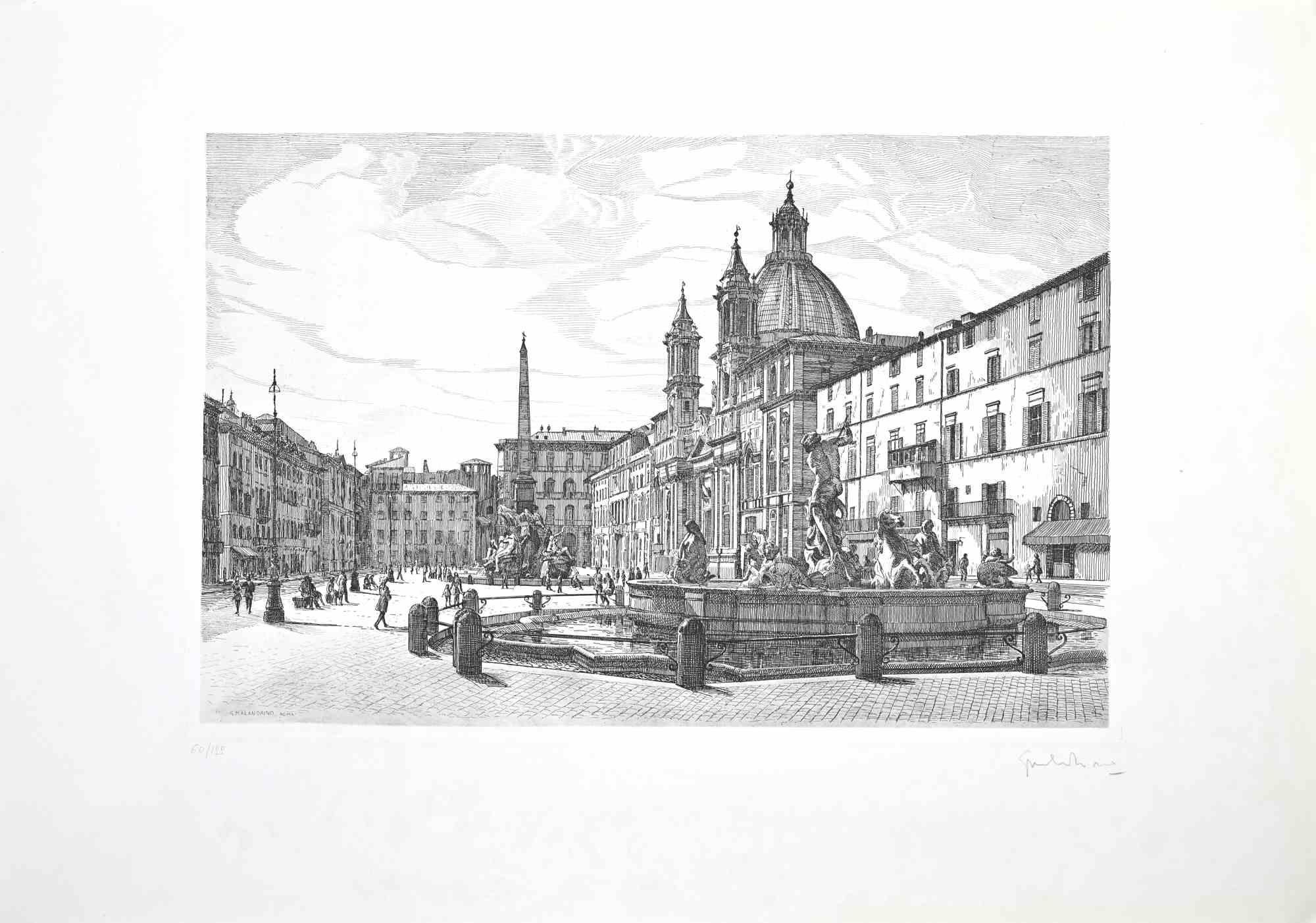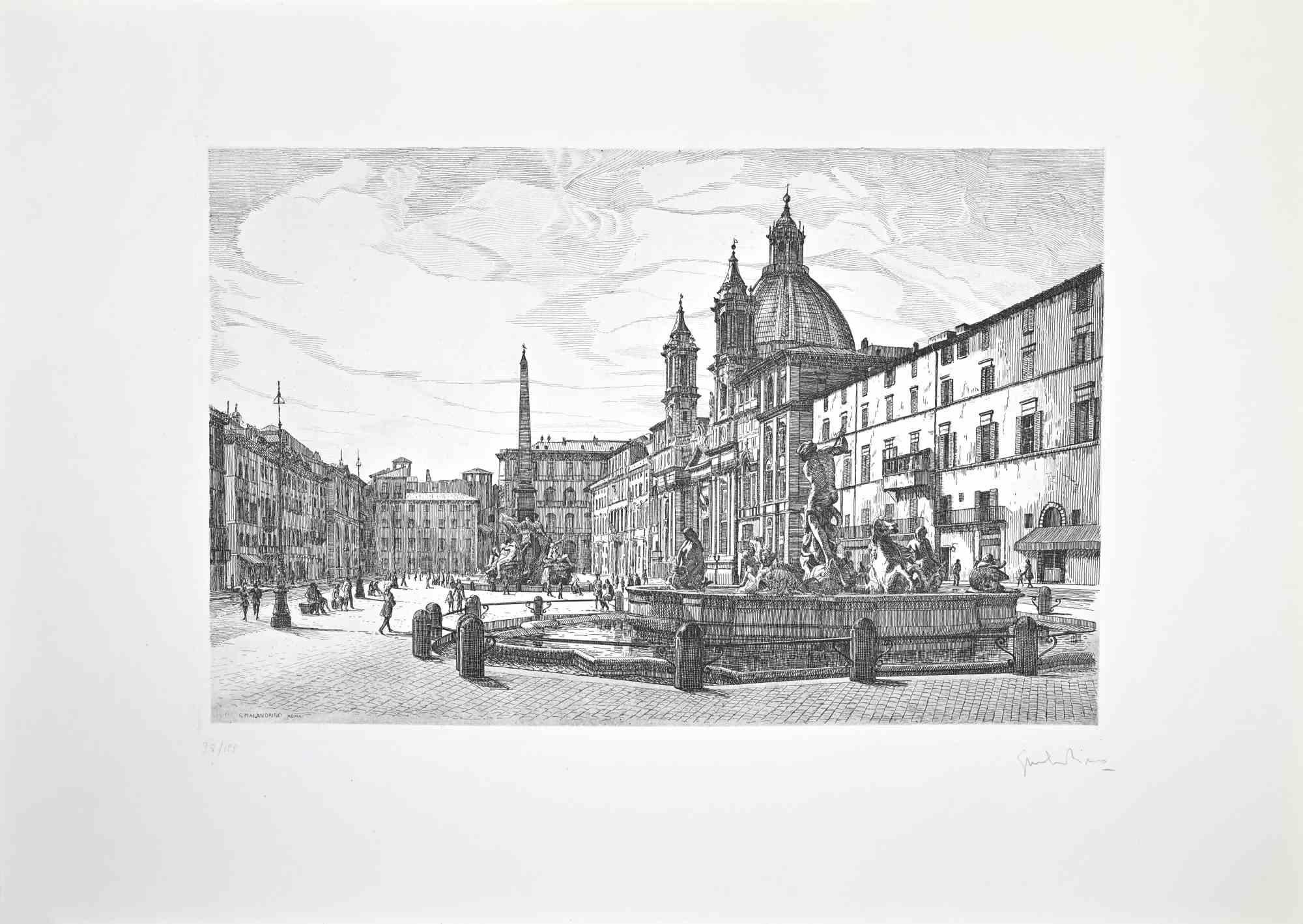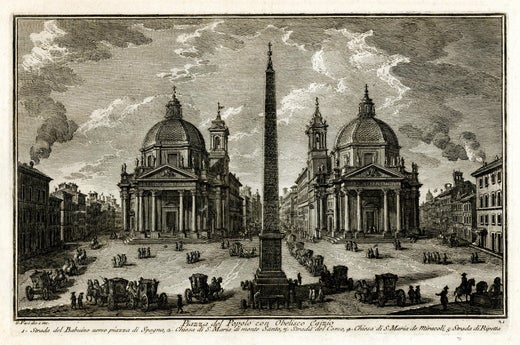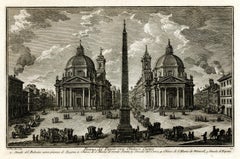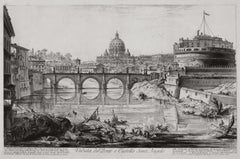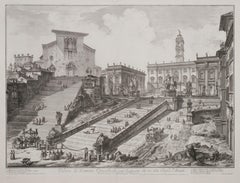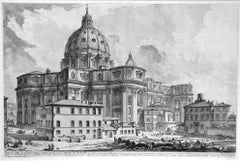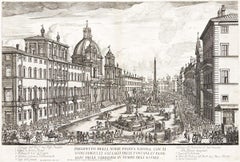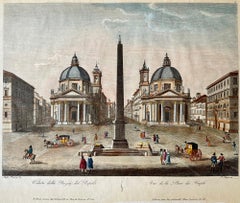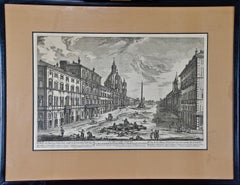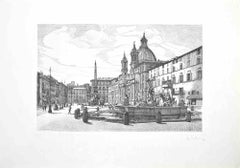Items Similar to Piazza Navona allagata solito farsi nelle Feste di Agosto
Want more images or videos?
Request additional images or videos from the seller
1 of 7
Giuseppe VasiPiazza Navona allagata solito farsi nelle Feste di Agosto1752
1752
$500
£377.34
€431.99
CA$705.17
A$774.18
CHF 403.89
MX$9,368.71
NOK 5,062.18
SEK 4,769.90
DKK 3,224.71
About the Item
Piazza Navona allagata solito farsi nelle Feste di Agosto
Etching, 1752
Signed in the plate lower right (see photo)
From: Della Magnificenze di Roma Antica e Moderna ( The Magnificense of Ancient and Modern Rome) , (1747-1761)
Volume II, The Main Squares and Obelisks, columns and other ornaments, 1752, Plate No. 26
Della Magnificenze di Roma Antica e Moderna_ (1747-61), a collection of 238 plates that was published in ten volumes. Vasi recorded all types of architecture and organized these images of contemporary Rome by subject, with each volume representing a different category of architecture. This comprehensive project provides one of the most complete views of eighteenth-century Rome
Condition: Excellent
Image/Plate size: 8 .25 x 12.63 inches
Sheet size: 11 x 15 7/8 inches
Vasi was Giovanni Battista Piranesi’s teacher. Piranesi (1720-1778) entered Vasi’s studio as an apprentice at age 20 c. 1740. Piranesi left Vasi’s employment after stabbing Vasi over the perception that Vasi was withholding secrets of the etching process.
Giuseppe Vasi was an Italian engraver and painter born and trained in Sicily. He received a classical education in his hometown of Corleone and trained as a printmaker in nearby Palermo, perhaps under the tutelage of the etchers Antonino Bova and Francesco Cichè. He moved to Rome in 1736, already an established printmaker, and spent most of his career documenting the urban landscape of the city in engravings. Through his patron, the politically and culturally influential Cardinal Troiano Acquaviva d’Aragona, Vasi met other artists working in Rome, such as Sebastiano Conca, Ferdinando Fuga, and Luigi Vanvitelli. He was also influenced by his predecessors, including Giovanni Paolo Panini, Giovanni Battista Falda and Gaspar Vanvitelli, and by the tradition of _vedutismo_ that these figures pioneered. During the early 1740s Vasi also served as mentor to the young Giovanni Battista Piranesi, to whom he taught the technique of single-cut engraving.
Vasi’s output can be organized into two categories, the first being his engravings of ephemeral structures, such as those used in the festival of the Chinea, while the second and more well-known and widely disseminated were his views of sites throughout Rome. Vasi’s first book, _Vedute del Tevere_ (1741-43), was a collection of these views. This book prefigured his later and most well known work, _Della Magnificenze di Roma Antica e Moderna_ (1747-61), a collection of 238 plates that was published in ten volumes. Vasi recorded all types of architecture and organized these images of contemporary Rome by subject, with each volume representing a different category of architecture. This comprehensive project provides one of the most complete views of eighteenth-century Rome. It acts as a pictorial supplement to Giovanni Battista Nolli’s famous map of Rome, _Pianta Grande_, completed in 1748. Nolli even supplied Vasi with measurements to aid in the drafting of his views of the city. In 1765 Vasi created a large, panoramic view of Rome for King Charles III of Spain, the _Prospetto dell’alma città di Roma_. The panorama, which measures 102.5 x 261.5 cm, consists of 437 engraved plates and is accompanied by several texts written by Vasi in the form of an _Itinerario_.
Over the course of his forty-six year career, Vasi established himself as one of the principle engravers of Rome. In addition to his own great works, Vasi collaborated with other printmakers such as Philothèe-Francois Duflos and Louis-Joesph Le Lorrain, and through his workshop contributed to such important books as Niccola Zabaglia’s 1743 _Castelli e Ponti_ and Giuseppe Bianchini’s _Evangeliario Quadruplex_ (1749). Through his extensive and didactic body of work, Vasi illuminated the urban and architectural landscape of eighteenth-century Rome, and through his relationships with patrons, publishers, and other artists he left his mark on the print culture of the city.
- Creator:Giuseppe Vasi (1710 - 1782, Italian)
- Creation Year:1752
- Dimensions:Height: 8.25 in (20.96 cm)Width: 12.63 in (32.09 cm)
- Medium:
- Movement & Style:
- Period:1750-1759
- Condition:
- Gallery Location:Fairlawn, OH
- Reference Number:Seller: FA126211stDibs: LU14015548052
Giuseppe Vasi
Giuseppe Vasi (1710-1782) was an Italian engraver and architect, best known for his illustrated 'Vedute Roma Antica' (views of ancient Rome), published from 1746 to 1761. Among his pupils was Giovanni Battista Piranesi. Piranesi worked together with him on the Vedute and some are signed both by Vasi and Piranesi. The two disagreed on the movement during their time to denigrate the work of Baroque architects, such as Bernini and Borromini. Vasi favored the more modern architectural approach approach and Piranesi favored the more classical architecture. They often had extreme disagreements and reportedly Piranesi threatened to kill his teacher.
About the Seller
5.0
Recognized Seller
These prestigious sellers are industry leaders and represent the highest echelon for item quality and design.
Platinum Seller
Premium sellers with a 4.7+ rating and 24-hour response times
Established in 1978
1stDibs seller since 2013
814 sales on 1stDibs
Typical response time: <1 hour
Associations
International Fine Print Dealers Association
- ShippingRetrieving quote...Shipping from: Akron, OH
- Return Policy
Authenticity Guarantee
In the unlikely event there’s an issue with an item’s authenticity, contact us within 1 year for a full refund. DetailsMoney-Back Guarantee
If your item is not as described, is damaged in transit, or does not arrive, contact us within 7 days for a full refund. Details24-Hour Cancellation
You have a 24-hour grace period in which to reconsider your purchase, with no questions asked.Vetted Professional Sellers
Our world-class sellers must adhere to strict standards for service and quality, maintaining the integrity of our listings.Price-Match Guarantee
If you find that a seller listed the same item for a lower price elsewhere, we’ll match it.Trusted Global Delivery
Our best-in-class carrier network provides specialized shipping options worldwide, including custom delivery.More From This Seller
View AllPiazza del Popolo con Obelisco Egizio
By Giuseppe Vasi
Located in Fairlawn, OH
Piazza del Popolo con Obelisco Egizio
Etching, 1752
Signed in the plate lower left (see photo)
From: Della Magnificenze di Roma Antica e Moderna ( The Magnificense of Ancient and Modern Rome) , (1747-1761)
Volume II, The Main Squares and Obelisks, columns and other ornaments, 1752, Plate No. 21
Della Magnificenze di Roma Antica e Moderna_ (1747-61), a collection of 238 plates that was published in ten volumes. Vasi recorded all types of architecture and organized these images of contemporary Rome by subject, with each volume representing a different category of architecture. This comprehensive project provides one of the most complete views of eighteenth-century Rome
Condition: Excellent
Image/Plate size: 8.25 x 12.63 inches
Sheet size: 11 x 15 7/8 inches
Vasi was Giovanni Battista Piranesi’s teacher. Piranesi (1720-1778) entered Vasi’s studio as an apprentice at age 20 c. 1740. Piranesi left Vasi’s employment after stabbing Vasi over the perception that Vasi was withholding secrets of the etching process.
Giuseppe Vasi was an Italian engraver and painter born and trained in Sicily. He received a classical education in his hometown of Corleone and trained as a printmaker in nearby Palermo, perhaps under the tutelage of the etchers Antonino Bova and Francesco Cichè. He moved to Rome in 1736, already an established printmaker, and spent most of his career documenting the urban landscape of the city in engravings. Through his patron, the politically and culturally influential Cardinal Troiano Acquaviva d’Aragona, Vasi met other artists working in Rome, such as Sebastiano Conca, Ferdinando Fuga, and Luigi Vanvitelli. He was also influenced by his predecessors, including Giovanni Paolo Panini, Giovanni Battista Falda...
Category
1750s Old Masters Landscape Prints
Materials
Etching
The Ponte and Castel S. Angelo (Veduta del Ponte e Castello Sant' Angelo)
By Giovanni Battista Piranesi
Located in Fairlawn, OH
The Ponte and Castel S. Angelo
Veduta del Ponte e Castello Sant' Angelo
Etching, 1754
Signed in the plate lower right above the caption
From: Vedute di Roma
A proper Roman printing w...
Category
1750s Old Masters Landscape Prints
Materials
Etching
Veduta del Romano Camipidpglio con scalinata che va alla chisea d’Araceli (The C
By Giovanni Battista Piranesi
Located in Fairlawn, OH
Veduta del Romano Camipidpglio con scalinata che va alla chisea d’Araceli (The Capitol and the Steps of S. Maria in Aracoeli)
Etching, 1775
Watermark: Double Circle Fleur de Lys
A lifetime impression with the price etching in the plate
Printed in Rome, before the plates are moved to Paris and the numerous posthumous editions
Reference: Hind 38 ii/IV
Robison 38 ii/V with the price
Wilton Ely 190
Condition: A fine Roman...
Category
1770s Baroque Landscape Prints
Materials
Etching
Veduta dell'esterno della gran Basilica di S. Pietro in Vaticano
By Giovanni Battista Piranesi
Located in Fairlawn, OH
Veduta dell'esterno della gran Basilica di S. Pietro in Vaticano (View of the Exterior of St. Peter's Basilica in the Vatican)
Etching, 1748
From the first printing of the "Vedute di Roma"
An early impression with strong contrasts
Before the price and the addition of numbers in the later states.
A view of Michelangelo's done from behind the Piazza, redesigned in 1547
Condition: Excellent
Plate size: 15 3/4 x 24 3/4 inches
Reference: Robison 5 a/g
Hind 5 i/VII
Focillon 54.789
Designed principally by Donato Bramante, Michelangelo, Carlo Maderno and Gian Lorenzo Bernini, St. Peter's is the most renowned work of Renaissance architecture and the largest church in the world. While it is neither the mother church of the Catholic Church nor the cathedral of the Diocese of Rome (these equivalent titles being held by the Archbasilica of Saint John Lateran in Rome), St. Peter's is regarded as one of the holiest Catholic shrines...
Category
1740s Old Masters Landscape Prints
Materials
Etching
S. Paolo Fuori Le Mura (Vedute della Basilica di S. Paolo fuor della mura)
By Giovanni Battista Piranesi
Located in Fairlawn, OH
S. Paolo Fuori Le Mura (Vedute della Basilica di S. Paolo fuor della mura)
Etching, 1748
From: Vedute di Roma, Plate 8
An early Roman printing, published by Bouchard e Gravier
Watermark: Fleur de Lys in a double circle
Signed in the plate
Condition: Small margins as are common with Bouchard published impressions.
Centerfold (as usual)
Rich impression with good contrasts
Plate/Image size: 15 7/8 x 24 1/8 inches
Sheet size: 17 3/8 x 24 3/4 inches
Reference: Focillon 723
Wilton-Ely 138
Hind 6 ii/VI, Bouchard e Gravier printing, before the price and numbers in later states
This image is Piranesi’s second interior scene from the Vedute di Roma. The first interior is a less complex composition of the Interior of St. Peters which lacks the challenging perspective that the artist masters in this image.
The Papal Basilica of St. Paul Outside the Walls...
Category
1740s Old Masters Interior Prints
Materials
Etching
Scene II, Le Nozze Degli Dei
By Stefano Della Bella
Located in Fairlawn, OH
Scene II, Le Nozze Degli Dei
Etching, 1637
Signed in the plate lower left
The scene depicts the initial moment when Diana is revealed, surrounded by her nymphs, celebrating a success...
Category
1630s Old Masters Landscape Prints
Materials
Etching
You May Also Like
Prospetto della nobil Piazza Navona
By Giovan Battista Falda
Located in New York, NY
A very good, richly-inked impression of this etching with strong contrasts and no sign of wear. Anchor or fleur-de-lys in a double circle watermark. From "Prospectus locorum urbis Ro...
Category
1670s Italian School Landscape Prints
Materials
Etching
Veduta della Piazza del Popolo
Located in Middletown, NY
Ruga, Pietro (after Luigi Magozza). Veduta della Piazza del Popolo. Rome: Giacomo Antonelli, 1825. Engraving with hand coloring in watercolor on cream wove paper with a "PM" watermar...
Category
Early 19th Century Italian School Landscape Prints
Materials
Watercolor, Handmade Paper, Engraving
Piazza Navona in Rome: A Framed Original 18th Century Etching by Barbault
Located in Alamo, CA
This early 19th century etching entitled "Veduta di Piazza Navona sopra le rovine del Circo" was created by Jean Barbault (1718-1762) after a painting by...
Category
Mid-18th Century Old Masters Figurative Prints
Materials
Etching
View of Piazza Navona - Etching by Giuseppe Malandrino - 1970s
By Giuseppe Malandrino
Located in Roma, IT
View of Piazza Navona is an original contemporary artwork realized in 1970 by the Italian artist Giuseppe Malandrino (Modica, 1910 - Rome, 1979).
Etching on cardboard.
Hand-sign...
Category
1970s Modern Figurative Prints
Materials
Etching
View of Piazza Navona - Etching by Giuseppe Malandrino - 1970s
By Giuseppe Malandrino
Located in Roma, IT
View of Piazza Navona is a contemporary artwork realized in 1970 by the Italian artist Giuseppe Malandrino (Modica, 1910 - Rome, 1979).
Etching on cardboard.
Hand-signed in pencil...
Category
1970s Modern Figurative Prints
Materials
Etching
View of Piazza Navona - Etching by Giuseppe Malandrino - 1970s
By Giuseppe Malandrino
Located in Roma, IT
View of Piazza Navona is an original contemporary artwork realized in 1970 by the Italian artist Giuseppe Malandrino (Modica, 1910 - Rome, 1979).
Etching on cardboard.
Hand-sign...
Category
1970s Modern Landscape Prints
Materials
Etching
